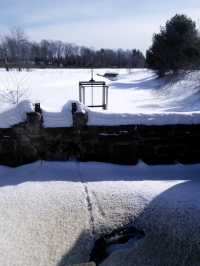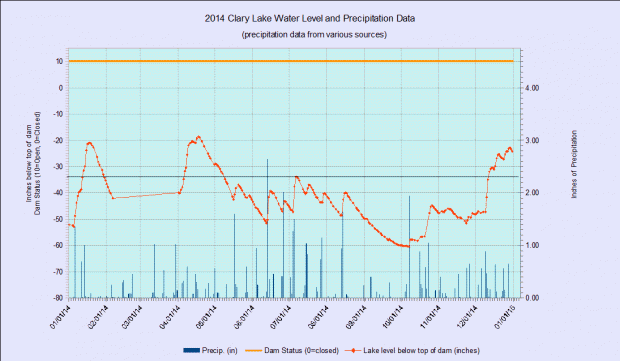 [dropcap]I’ve[/dropcap] archived the October 2015 water level chart (at left). The most notable thing about it is that sometime during the weekend of October 17/18 the gate on the dam was almost completely closed. The gate had been wide open since October 13, 2012. The gate still remains open about 3″ or 4″ or so, presumably so as to provide the minimum outlet flows calculated for Clary Lake and required in the Clary Lake water level order (WLO). Regrettably, the gate opening still allowed too much water to be released as the lake level continued to fall albeit at a somewhat slower than usual rate: the lake level dropped 0.15′ (1.80″) over the next 10 days (0.18″ per day; normal for this water level would be 0.25″ per day) until the 29th when we received 2.3″ of rain in one intense 12 hour storm. That the lake continued to fall after the gate was lowered clearly indicates that outflows from the dam exceeded inflows into the lake by measurable amount, which means too much water was being released. In my copious spare time I’ve been working on a post about minimum flows but it’s not ready so I’m not going go into them now. Minimum flows are fully explained in the Department of Environmental Protection Rules, Chapter 587: IN-STREAM FLOWS AND LAKE AND POND WATER LEVELS. While that’s not an easy document to wade through, it makes for interesting reading and fully explains the the purpose of minimum flows.
[dropcap]I’ve[/dropcap] archived the October 2015 water level chart (at left). The most notable thing about it is that sometime during the weekend of October 17/18 the gate on the dam was almost completely closed. The gate had been wide open since October 13, 2012. The gate still remains open about 3″ or 4″ or so, presumably so as to provide the minimum outlet flows calculated for Clary Lake and required in the Clary Lake water level order (WLO). Regrettably, the gate opening still allowed too much water to be released as the lake level continued to fall albeit at a somewhat slower than usual rate: the lake level dropped 0.15′ (1.80″) over the next 10 days (0.18″ per day; normal for this water level would be 0.25″ per day) until the 29th when we received 2.3″ of rain in one intense 12 hour storm. That the lake continued to fall after the gate was lowered clearly indicates that outflows from the dam exceeded inflows into the lake by measurable amount, which means too much water was being released. In my copious spare time I’ve been working on a post about minimum flows but it’s not ready so I’m not going go into them now. Minimum flows are fully explained in the Department of Environmental Protection Rules, Chapter 587: IN-STREAM FLOWS AND LAKE AND POND WATER LEVELS. While that’s not an easy document to wade through, it makes for interesting reading and fully explains the the purpose of minimum flows.
[dropcap]At[/dropcap] 45.84″ below the top of the dam, the lake level is higher now than it’s been since May 21st of this year. As high it seems that is still more than 2′ lower than it should be this time of year (no more than 2′ below the top of the dam). The 2.3″ rainstorm on the 29th brought the lake level up 8.76″ for a runoff multiplier of 3.8x which is still a little low indicating that runoff is somewhat reduced because the ground is still relatively dry and a lot of the rain is soaking in rather than running off. Average yearly rainfall for our area is about 42″ and as of the end of October, we’ve received only 29.41″ or more than 12″ less than normal, and only 2 months to make up the difference. Unlikely.
[dropcap]I[/dropcap] hate taking my boat out and I usually put off hauling out in the fall as long as I can. I think however I will take advantage of this increased lake level and haul my boat out tomorrow.









 I’ve
I’ve 











